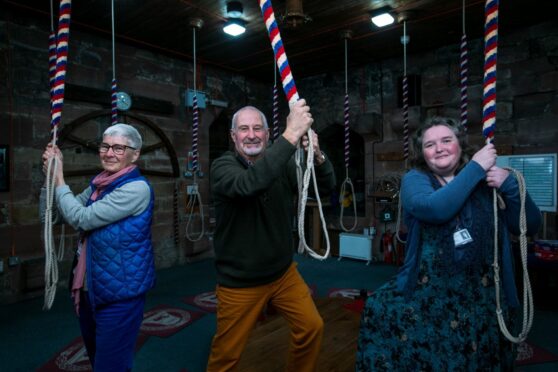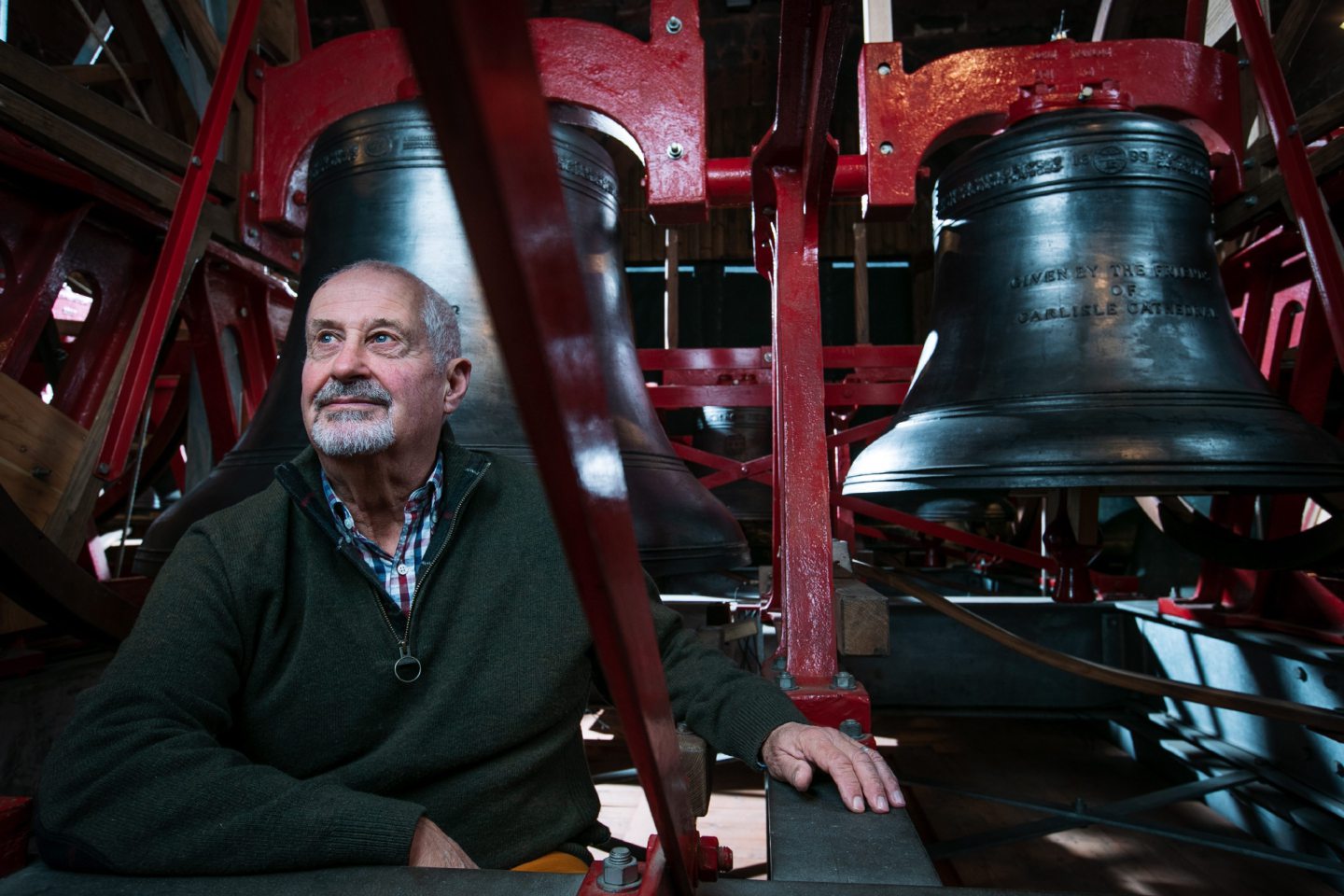
“We give thanks for Saint Andrew and we pray for the people of Scotland.”
It’s 8am on November 30 and, in Carlisle Cathedral, the Reverend Canon Michael Manley is offering up a prayer for St Andrew’s Day. Outside it’s not quite light yet. Inside the lights are on, partly illuminating the wood and stone of the cloister otherwise still soaked in cathedral gloom. Owen Jones’s remarkable starry ceiling flares on the eye when you look up.
Apart from Manley, the Canon Warden Dr Benjamin Carter and myself there is only one more member of the congregation this morning. I think. Everyone is behind me so I can’t be sure. I sit and stand and sit again, mumbling through unfamiliar responses in an unfamiliar place. And part of me is wondering why it’s so unfamiliar.
Carlisle is the great border city and at its heart is this building, an epic in stone that this year celebrates its 900th anniversary. An epic in stone and a repository of memory. These walls carry the weight of a shared history. The history of Scotland and England.
Robert the Bruce was excommunicated in this cathedral in 1306. Jacobite prisoners were held here for a night on their journey to London after the Battle of Culloden. Sir Walter Scott married Charlotte Charpentier in the cathedral on Christmas Eve, 1797. From the roof hang the colours of the Border Regiment. Scottish history is in its very bricks.
“Mary, Queen of Scots is reputed to have worshipped here when she was imprisoned at Carlisle Castle,” Heather Purves, a volunteer guide at the cathedral tells me.
And this building is here in the first place because of the border just a few miles north, she points out.
“In my mind the raison d’etre for this building is Scotland-England,” says Purves. “Carlisle isn’t in the Domesday Book because when they compiled the Domesday Book Carlisle belonged to Scotland.”
It was William Rufus (William II) who brought Carlisle back under English rule and in 1122, with William’s brother Henry on the English throne, an Augustinian Priory was established in Carlisle, which became a cathedral in 1133, a reminder to everyone that this was English land (though it went back and forth until the 13th Century).
A marker in stone, one we often ignore today. Driving up the M6 towards the border I have to admit I never stop at Carlisle. Well, why would you, when you’ve already popped into Tebay services down the road?
And yet the story of Scotland and England, the story of how these two countries entwine and interconnect is still playing out in Carlisle and in this cathedral nine centuries after it was founded. To spend any time here is to be reminded that the border is not a barrier but a line that is crossed every single day by the people who live on either side of it. And the cathedral is a fulcrum for many such journeys.
“Before I came here I wouldn’t have stopped because you’re nearly home,” admits Edith McColgan, originally from Lochwinnoch and now the cathedral’s chief operating officer. She has been in England for 32 years and now reckons Carlisle is “the best place to stop”.
It is McColgan’s job to keep the cathedral going. At the moment, she admits, that’s difficult. She says: “The visitors haven’t come back, the congregation hasn’t come back to where they were. The cost of living crisis, the energy crisis. It’s a perfect storm.
“People think cathedrals have lots of money and they absolutely don’t. We are predominantly self-funding. It’s £2,700 to £2,800 a day to keep that cathedral open on donations, which is challenging.”
That said, the cathedral has benefited, she points out, from a £3.5 million redevelopment of the Fratry building and the addition of a new cafe which has helped transform the cathedral precinct. The latter is where I meet Carter. Originally from Morecambe Bay, he was 30 when he was ordained in Newcastle upon Tyne. He then spent most of the next 15 years working his way “along Hadrian’s Wall” to arrive in Carlisle in April last year.
He is very much a Carlisle convert. He says: “It’s a real hidden gem, not just in England but in the life of the north, I think. As you say, people drive past it. They don’t realise it’s here. I think the cathedral is a magnificent space. It offers that grandeur and sense of awe and majesty that cathedral buildings give us, a sense of a spiritual relationship to something; the great otherness. But because it’s relatively small, for various historic reasons, it’s also quite an intimate space as well.”
What does a canon warden do? He explains: “I do three things. The most important is that I turn up and say my prayers, because for the last 900 years, with the odd Oliver Cromwell-affected exception, there has been a community of priests whose task has been to live and work here and say prayers every day. So that’s the most important thing that we do. And then everything else flows from there.”
He is also involved in the cathedrals’s governance and is responsible for “engagement” with the wider world, particularly important in an anniversary year. “And then, of course, we’re just about to come into – as everyone likes to tell me – our busy season.”
Carlisle Cathedral is, Carter suggests, a place of rest at the heart of a restless history between Scotland and England, from the wars of independence to the years of the Border Reivers. What part does the border play in the cathedral’s story today, I ask?
“We have to be honest. We’re a Church of England cathedral. We are the diocese of Carlisle and we know where our patch is,” he says.
“We also know where our patch isn’t. So we always have to be very careful that we’re not fishing in someone else’s pond. But we also recognise that Carlisle is the great border city for a huge expanse of land. If you’re down in Wigtown or Whithorn or further beyond, Carlisle’s a lot closer than Glasgow. So I think there is a sense that people do come here and we’re trying to find ways of engaging with that border community.”
You climb 137 steps to reach the ringing room in Carlisle Cathedral, round and round and up, climbing high above the altar, through the walls, past graffiti scratched into the stonework (“Noddy + Rick 66)”. This is a journey Michael and Amanda Rodger and Ruth Gilbert make twice a week, a journey that begins in Powfoot for the Rodgers and Rowanburn in Gilbert’s. Border crossings in both cases.
Amanda, a former tax inspector and postie, is English. She went to school in Carlisle. The other two see themselves as Scottish.
“I’m a true borderer,” says Gilbert. “My family name is Coulthard. The Coulthards were one of the Border Reiving families. My family have farmed the same farm on the English side of the border for well over 300 years.”
She works in the NHS as a radiographer. She has been ringing for nine years. In the ringing room they teach me something about the art of bell ringing. It is, Gilbert says, all about skill rather than strength.
“It’s more like yoga,” she says.
“It’s about control,” adds Amanda.
“The biggest bell is as heavy as a car,” her husband, a retired design lecturer, points out. “You can tell a new ringer because they will struggle on that bell because of the weight of it. But when Amanda rings you’d think there was nothing on the end of it. It’s technique. It’s ropecraft.”
I ask them about the cross-border journey they all make to ring these bells. Does the border mean anything to them?
Covid brought the idea of two different countries into sharp focus for them. “We crossed the border willy-nilly, suggests Michael. “It wasn’t there, was it? Until Covid. And that’s when it starts to hammer home to you the possible implications of a border.”
Brexit had a similar effect, it seems. “The only time when I felt that there was a very different thing about being in Carlisle than in Scotland was when we had the Brexit vote,” suggests Gilbert, “and the conversations when I was at home versus when I was at work were radically different and that was the only time when I felt I had crossed the border, apart from Covid.”
But the truth of the matter is that for all three of them Carlisle Cathedral represents cross-border connections rather than divisions. Ruth Gilbert rings the bells in the cathedral and then crosses back over the border to attend a service in her own church in Canonbie. Like Heather Purves, she is an elder in the Church of Scotland. The bell ringing is more than just a hobby. She says: “I see it as part of my faith.”
Late afternoon and the consort choir is practising scales in the cathedral. Later this evening there will be an Intensive Care Unit Memorial Service for those who have died this year.
Brihannon Strathern should be with her fellow choir members but she is sitting talking to me instead. Strathern is 22 and works in retail at Gretna Gateway. Originally from Essex, her family moved to Gretna when she was three. She has been singing in the cathedral since she was nine.
“I currently sing alto, but, really, I am a soprano. I do a bit of both when it’s needed,” she says.
Even though she has lived in Gretna for most of her life she still sees herself as English. “Personally, I don’t really see a border,” Strathern admits. “I went to school in Carlisle. I was travelling in every day. And when there was talk of Scotland becoming independent I was like, ‘How am I going to get to school? Will I have to show a passport in order to get into school?’ But luckily that never happened.
“I think if you’re living in the borders you don’t acknowledge the fact that you’re living in the borders. You’re just there.”
Carlisle Cathedral is just there too. A place of rest in a restless world, as Canon Benjamin Carter suggests. Something to remember when you’re next travelling up the M6 towards Scotland. Maybe give Tebay a miss for once.

Enjoy the convenience of having The Sunday Post delivered as a digital ePaper straight to your smartphone, tablet or computer.
Subscribe for only £5.49 a month and enjoy all the benefits of the printed paper as a digital replica.
Subscribe © Andrew Cawley
© Andrew Cawley